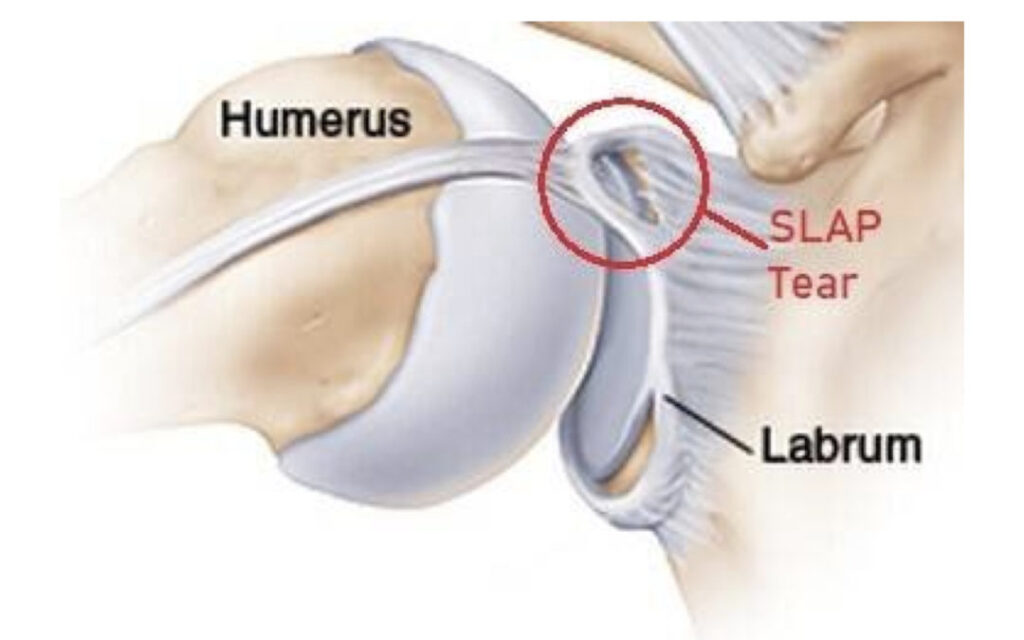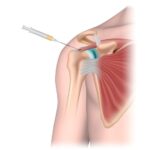Shoulder Labral Tears
Shoulder labral tears are a common acute injury.
The shoulder labrum is a piece of soft cartilage in the socket-shaped joint in your shoulder bone. It cups the ball-shaped joint at the top of your upper arm bone, connecting the two joints.
A group of four muscles called the rotator cuff helps the labrum keep the ball in the socket. This allows your upper arm to rotate. Repetitive motion and injuries can tear the labrum, often causing pain.
How are shoulder labral tears diagnosed?
The best way to diagnose a labral tear is by seeking an evaluation from an experienced doctor, like our team at Ohio Healthcare Partners.
If a labral tear is suspected, further imaging is needed to confirm the diagnosis.
Further imaging in the form of an MRI with contrast is typically ordered. This form of MRI is a little different than a typical MRI because a dye is injected into the affected joint. This dye adds to the imaging test because the fluid from the dye can sneak under the tear and make it easier to detect on the images. This is the best way to interpret a labral tear short of having surgery.

Types of Labral Shoulder Tears
There are several different types of shoulder labral tears that can occur. These include SLAP tears, anterior tears, and posterior tears.
- SLAP tear stands for “Superior Labrum Anterior Posterior” which means that the tear is in the upper part of the labrum and extends to the back and the front of the labrum. This kind of labrum tear is common among tennis and baseball players, as well as anyone who uses a lot of overhead arm motions. They also often occur with damage to the biceps tendon.
- An anterior tear means that the front part of the labrum is torn.
- A posterior tear means that the back portion of the labrum is torn.
Symptoms of shoulder labral tears
A labral tear is usually painful.
It may feel like your shoulder joint is:
- catching
- locking
- popping
- grinding
You may also feel a sense of instability in your shoulder, a decreased range of motion, and a loss of strength. Pain at night or while doing daily activities is also common with a labral tear.
All types of shoulder labral tears often occur with other shoulder injuries, such as dislocated shoulders, rotator cuff injuries, and torn biceps tendons. Our doctors will determine exactly what type of injury you have.
If your shoulder pain is caused by a work-related injury, Ohio Healthcare Partners is an Ohio Bureau of Workers’ Compensation certified provider.
Non-Surgical Treatment Options for Shoulders at Ohio Healthcare Partners
Joint Injections
When joint pain does not resolve in a reasonable amount of time with OTC medication and/or physical therapy, an injection of medication directly into the joint is a frequently performed procedure.
What is in a joint injection?
 A joint injection typically contains a local anesthetic and a corticosteroid. The local anesthetic, similar to what you might receive at the dentist, provides early pain relief, while the steroid suppresses inflammation and decreases swelling for long-term pain relief.
A joint injection typically contains a local anesthetic and a corticosteroid. The local anesthetic, similar to what you might receive at the dentist, provides early pain relief, while the steroid suppresses inflammation and decreases swelling for long-term pain relief.
In addition to treating joint pain, injections are used as a diagnostic tool. The local anesthetic has a numbing effect on the joint, and the amount of immediate pain relief experienced will help confirm or rule out the joint as a source of pain.
How are shoulder joint injections administered?
A joint injection is used to treat inflammatory joint conditions such as arthritis, gout, bursitis, tendonitis, and osteoarthritis.
The injection is performed by using ultrasound to guide exactly where the needle needs to go into the affected joint and distributing an anti-inflammatory agent. The most common of these is a corticosteroid (cortisone shots).
What can be expected after a shoulder joint injection?
After the injection, you may experience immediate but temporary pain relief from the local anesthetic.
Because steroids need a few days to deliver noticeable benefits, there is a chance of the pain returning or even worsening. If the pain worsens, it usually subsides within a day or two.
Generally, it’s recommended that you take it easy the day of the procedure, but return to your usual activities the following day. You can ice down the injection site and take an over-the-counter NSAID, like ibuprofen, for pain relief.
Although joint injections do not change the underlying condition, they can break the cycle of pain and inflammation and allow time for exercise or physical therapy to strengthen muscles and get the joints moving again in order to decrease ongoing problems.
We combine all of our shoulder therapy treatment plans with a combination of comprehensive therapeutic exercises, chiropractic care, and medical massage to achieve maximum results with our program!
To learn more about our Comprehensive Shoulder Treatment Options, contact our team at Ohio Healthcare Partners in Akron, Ohio.



